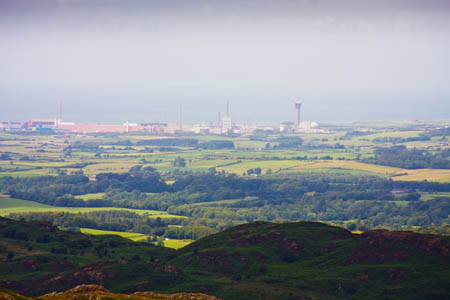An authority says building three new nuclear power stations close to England’s biggest national park could have a serious impact on tourism and the natural environment.
Government plans to construct additional plants in west Cumbria are ‘not acceptable’, according to a report prepared for the Lake District National Park Authority published today. The report says the national park could probably cope with the extension of the existing nuclear facility at Sellafield, but new Greenfield sites at Braystones and Kirksanton would affect tourism and other industries in the area.
Both proposed additional sites, the former north of Sellafield and the latter west of Millom, lie just outside the national park boundary on the Irish Sea coast. Part of the Kirksanton site lies within a flood risk zone and the planned plant would be close to the Duddon estuary special protection area and site of special scientific interest. The Silver Tarn, Hollas and Harnsey Mosses SSSI is close to the Braystones site, which lies just 6km (3¾ miles) from the start of the popular Wainwright’s Coast to Coast Walk at St Bees Head.
Both applications are by RWE Npower, owned by German company RWE.
A meeting of members of the authority in Kendal formally agreed to support the Sellafield plans, but ‘strongly oppose’ the two other developments.
The report, from director of planning and partnerships Steve Ratcliffe outlined the authority’s response to a Government public consultation exercise launched last November to gauge opinions for a new energy infrastructure. It looked not only at possible sites for nuclear plants but also the issues of connecting and supplying generated power to the rest of the country’s energy networks.
Mr Ratcliffe said: “The Lake District National Park Authority has severe concerns about the cumulative impact of nuclear power stations in west Cumbria. Nuclear power stations and their ancillary development, which is likely to include the erection of waste stores on each site, by their scale and type, have significant landscape and visual impacts.”
The existing site at Sellafield is visible by walkers and climbers on many of the Lake District’s western peaks.
“In this sensitive Lake District landscape with limited capacity to absorb large scale development it is difficult to see how the suggested development, whatever the design, can result in anything but substantial adverse visual impact and damage to the landscape character,” the report continued.
“There is the potential for an adverse impact upon the economic and social wellbeing of the inhabitants of the national park and surrounding areas by affecting the recreation and tourism potential of the area.”
There was, however, recognition of the economic benefits of enlarging the existing Sellafield site, which grew around Britain’s first commercial nuclear reactor at Calder Hall. This would ‘stabilise the existing economy and provide some surety for businesses and employment which depend on the nuclear industry’.
The report urged the Government to consider implications for Cumbria and the Lake District, in particular:
- the prosperity of the tourist industry and other non nuclear businesses
- the potential harmful effects on landscapes and cultural heritage
- the consequences for roads and other transport systems
- the affect on the ecology of special environmental areas such as coastal dunes and lagoons.

Sam
21 January 2010I'd rather have nuclear power stations than windfarms.
Mrs Lorraine Wilson
21 January 2010As a very concerned owner of a self- caterng holiday accommodation in Kirksanton there is no doubt that this potential build of a new nuclear power station in Kirksanton is already having a detrimental effect on tourism. The over exposed promise of jobs created by the new build outways the hard work and investments many tourist related business surrounding this build, How will DECC and RWE mitgate the loss of our bussiness